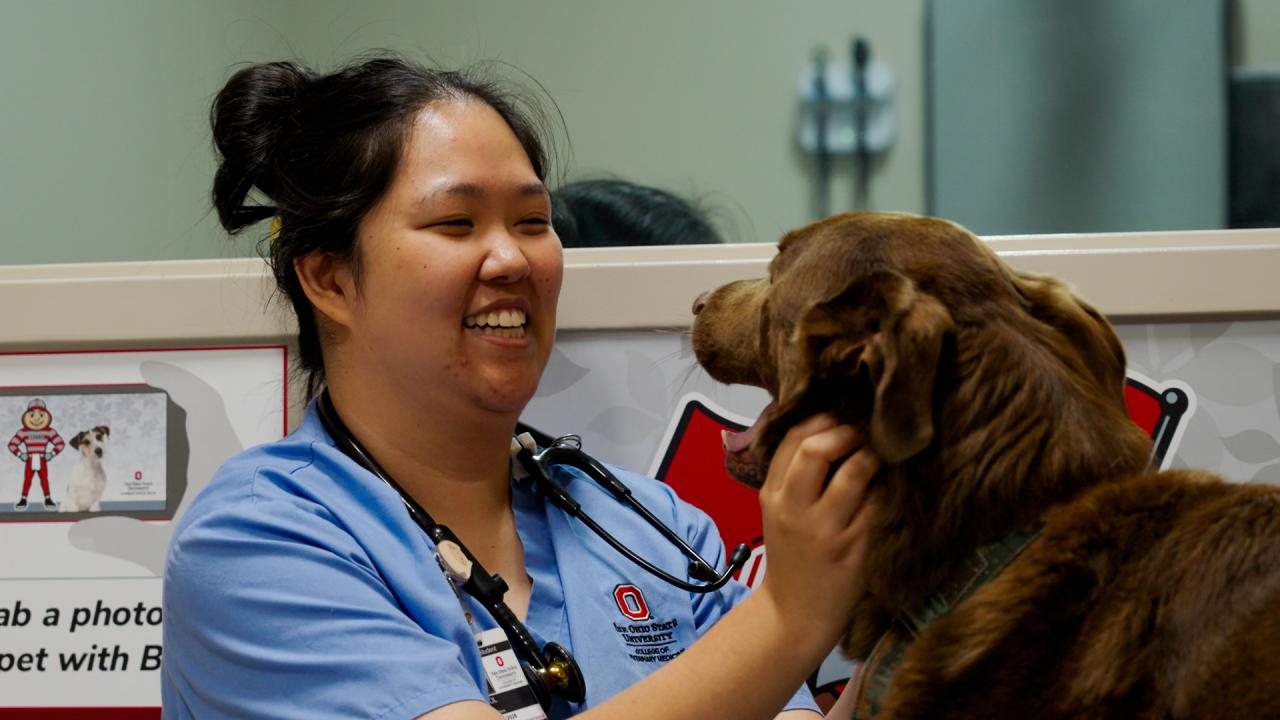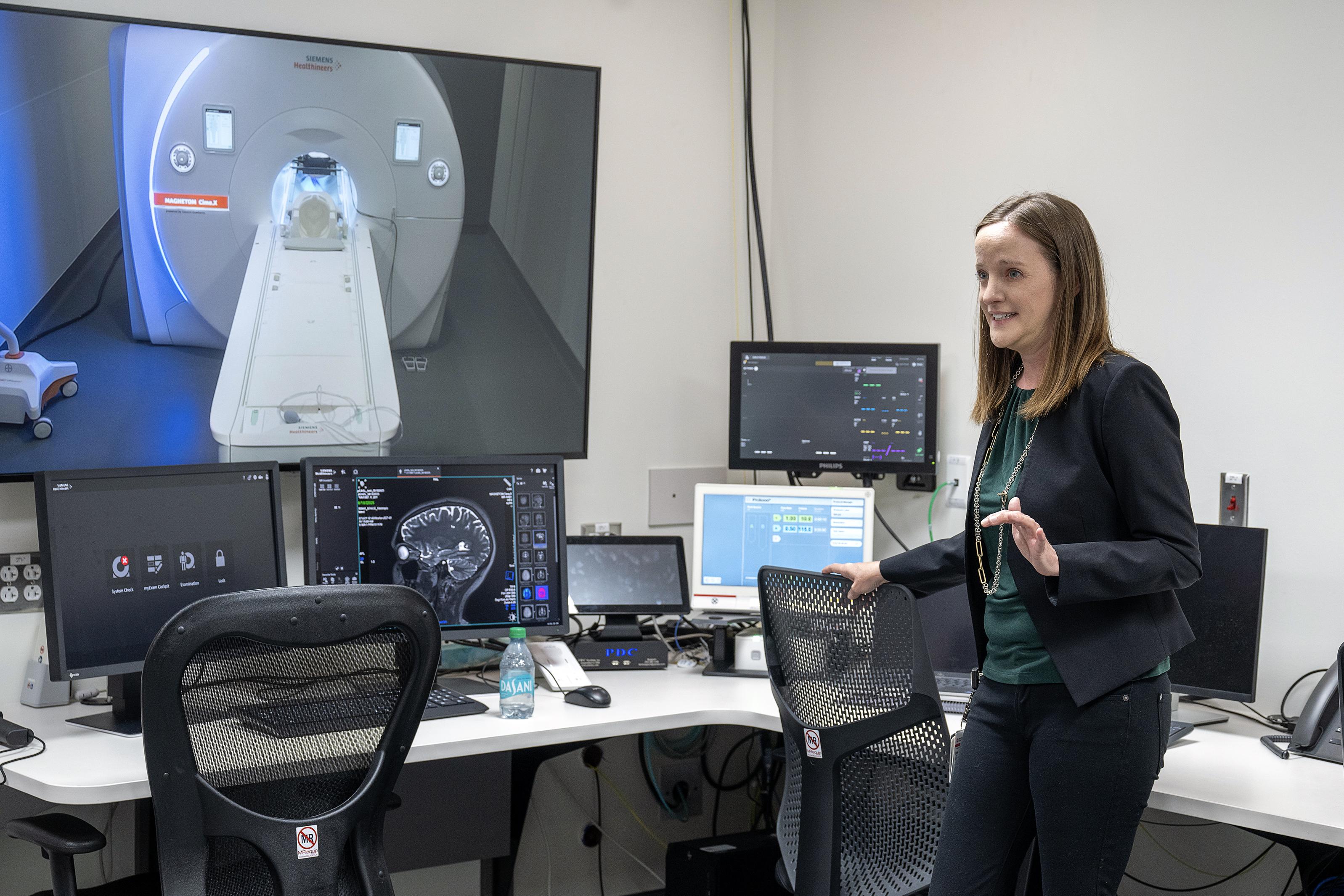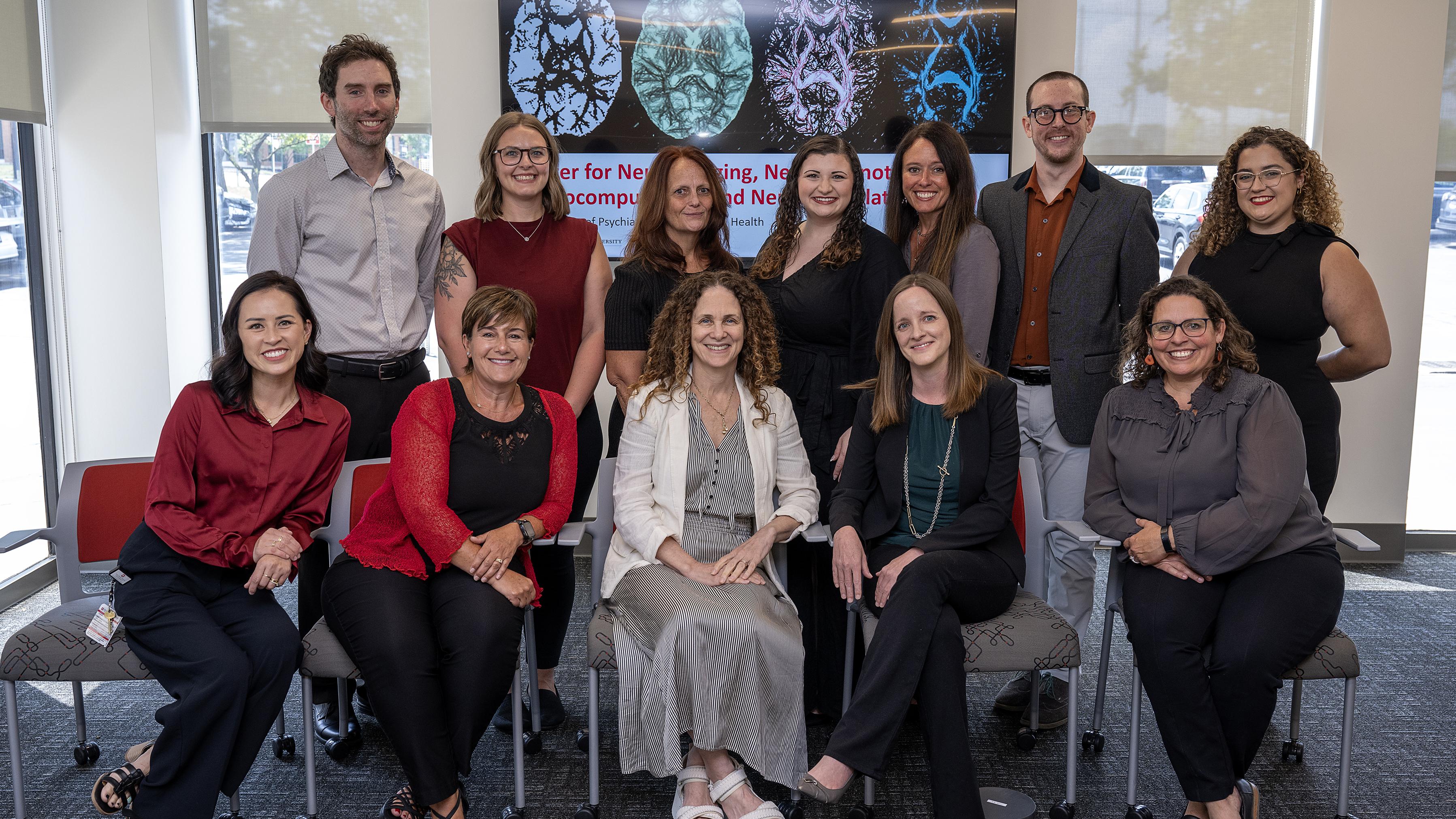Students in Ohio State’s College of Veterinary Medicine gain hands-on experience, thanks to the vision and legacy of Frank Stanton.
Amplifying faculty impact
Endowed chair gifts fuel innovations in care and wellness

Just inside the Frank Stanton Veterinary Spectrum of Care Clinic (SOCC) is a striking, wall-length photo of a man gazing at a beloved dog on his knee. It’s a universal image of companionship — Everyman and Everydog. But this man is Frank Stanton ’32 MA, ’35 PhD, ’49 HON, president emeritus of CBS and the clinic’s namesake.
At its annual Celebration of Excellence event in September, The Ohio State University posthumously recognized Stanton with its top philanthropic honor: the Everett D. Reese Medal. Also honored was Lee Shackelford, MD, who received the distinguished John B. Gerlach Sr. Development Volunteer Award.
Both donors have established endowed chair positions, enabling some of Ohio State’s top faculty to reach new heights in their careers and advance research pursuits that benefit us all.
Through their generous gifts, Stanton and Shackelford have demonstrated a deep understanding of the impact of empowering others — and the importance of caring for both animal and human well-being.
Lifelong lover of dogs sees a need
When Stanton was a student at Ohio State in the 1930s, he and his wife, Ruth, had a Boston terrier puppy that needed care. They got the help they needed thanks to Ohio State’s veterinary clinic.
Decades later, Stanton found a large bill in hand, this time for his Welsh Corgi at an East Coast specialty hospital. Despite a booming career and ample resources, Stanton wondered what happens when people can’t afford care. The answer — that owners often must forego treatment — was unacceptable to him.
On the spot, he wrote a $300,000 check to the specialty hospital to pay for veterinary care that owners could not afford. Within weeks, he was shocked to learn the funds were gone, so great was the need for assistance.
Such experiences inspired Stanton to give back to his alma mater in a lasting way. In 2002 — to honor Ruth’s passing and recognize their shared gratitude for their dog’s care — Stanton created an endowed chair in her name at Ohio State.
Extending a legacy of care
The Ruth Stanton Chair in Veterinary Medicine at the College of Veterinary Medicine is held by Emma Read, DVM, MVSC, DACVS, associate dean for professional programs. Read is known globally in the industry for her expertise in spectrum-of-care course design and assessment, among other specialties.
In her role, Read leads a novel curriculum built on experiential learning. The approach equips students with early and routine hands-on clinical skills. It includes competency-based assessments and advances a spectrum-of-care emphasis on general practice — which entails providing accessible, effective and affordable care through a range of diagnostic and treatment options. The model is being widely replicated in veterinary education.
This innovative method comes to life every day in the SOCC, which opened in 2021. “The clinic was purpose-built, including nine exam rooms with one-way glass, through which faculty can view and coach student interactions with clients,” Read says.
“This puts students into a clinical practice from day one of their veterinary training, tackling everything from managing a boisterous dog to spaying and neutering,” she adds. “We are shifting the mindset. Now, students can truly become part of the medical team, in real life and in action.”

Left to right — Liesa Stone, DVM; Roger Fingland, DVM; Elisabeth Allison, PhD; Rustin Moore, DVM; and Emma Read, DVM.
Under Read’s leadership, the clinic prepares confident and competent veterinarians while providing compassionate care for every patient, building upon Stanton’s legacy of easing clients’ financial burdens.
Igniting a movement
In 2006, the Stanton Foundation was established with Frank’s passing at the age of 98. It created the Frank Stanton Chair in General Practice and Canine Health and Wellness in 2016 to honor his legacy. Roger Fingland, DVM, MS, MBA, DACVS, vice dean and professor, holds the position and serves as executive director and chief medical officer of the veterinary health system.
“People come from all over to see what we have created,” says Fingland, who laid the first brick of the clinic with a picture of Stanton taped to it. “It started right here, a new spectrum-of-care curriculum that’s setting the model for the nation. From Frank’s gift, a movement has grown.”
Both Fingland and Read play a vital role in providing innovative veterinary education at Ohio State. “The Stanton Foundation is proud to partner with Ohio State to advance a new, immersive curriculum model. It will impact generations of veterinarians, caring for countless pets,” says Elisabeth Allison, codirector of the foundation.
Creating a hub for advanced brain research
A mile from the veterinary clinic, human patients are receiving care at the new Center for Neuroimaging, Neurophenotyping, Neurocomputation, and Neuromodulation (C4N). As part of the Department of Psychiatry and Behavioral Health, experts are exploring the complexity of the human brain.
Together, they share knowledge and drive innovation to address pressing challenges in neuroscience and find insights that can improve clinical care. “Mental health is a public health crisis, and we’re committed to finding solutions,” says Nina Kraguljac, MD, MA, founding director of C4N and the Dr. Lee E. Shackelford Chair in Psychiatry and Behavioral Health.
Kraguljac spearheaded the vision for C4N. When its doors opened in April 2025, she knew the center would elevate our understanding of brain-related conditions. It offers a suite of leading-edge technologies — including one of the strongest 3T MRI systems on the market — designed for visualizing and understanding the brain.

Dr. Kraguljac speaks with guests, showing them state-of-the-art equipment at the C4N open house.
“Brain function abnormalities related to mental health can be subtle and aren’t always easily visible,” Kraguljac says. “But making these things visible, through advanced imaging and computing, can yield new treatments for the right patient at the right time.” Like Dr. Shackelford, she is concerned about the stigma attached to mental health.
“As an ER psychiatrist, I’m often seeing patients at the worst moment in their lives. I want them and their families to understand there’s no need for guilt,” Kraguljac says. “Our research at C4N is going to help make that case so that patients can better advocate for themselves.”
Shackelford is also passionate about advocacy. “Central to the mission of lifting one’s community is creating the conditions that offer wellness to all,” Shackelford says. “It has been the joy of my life to be part of growing our psychiatry department, including supporting Dr. Kraguljac and her research. It’s a logical outgrowth of my family’s commitment to investing in people.”

Dr. Kraguljac, first row, second from right, and her team at the C4N open house.
Kraguljac is grateful for her support, which Shackelford upgraded from a professorship to an endowed chair position. This increased investment allows Kraguljac to lead a team of 12 focused on expanding the frontier of therapeutic discoveries in brain health and psychiatry.
“That’s been the biggest gift: having the space, freedom and support to do high-risk research in early stages — the kind of research that’s typically not funded but will undoubtedly improve lives,” she says.